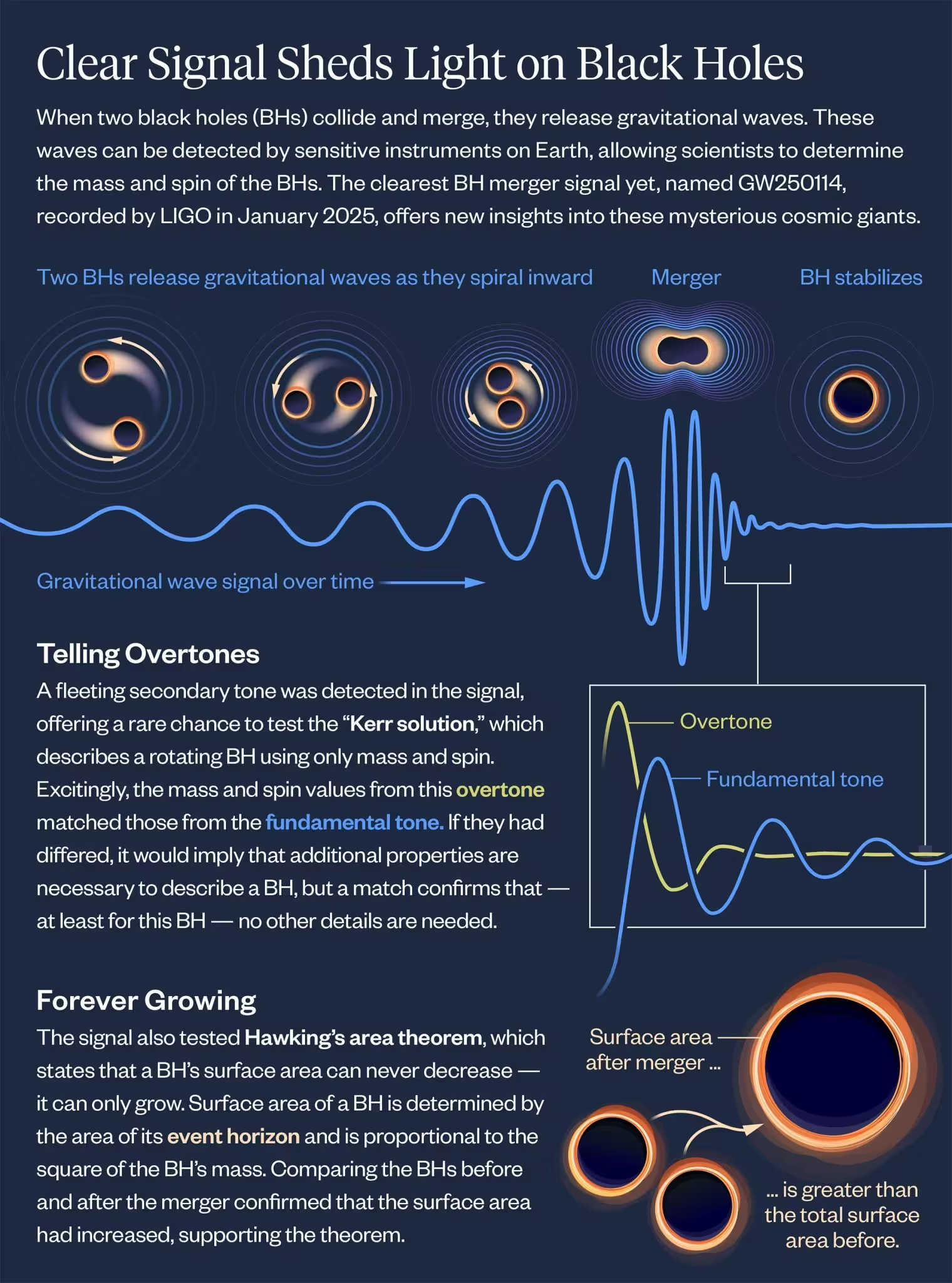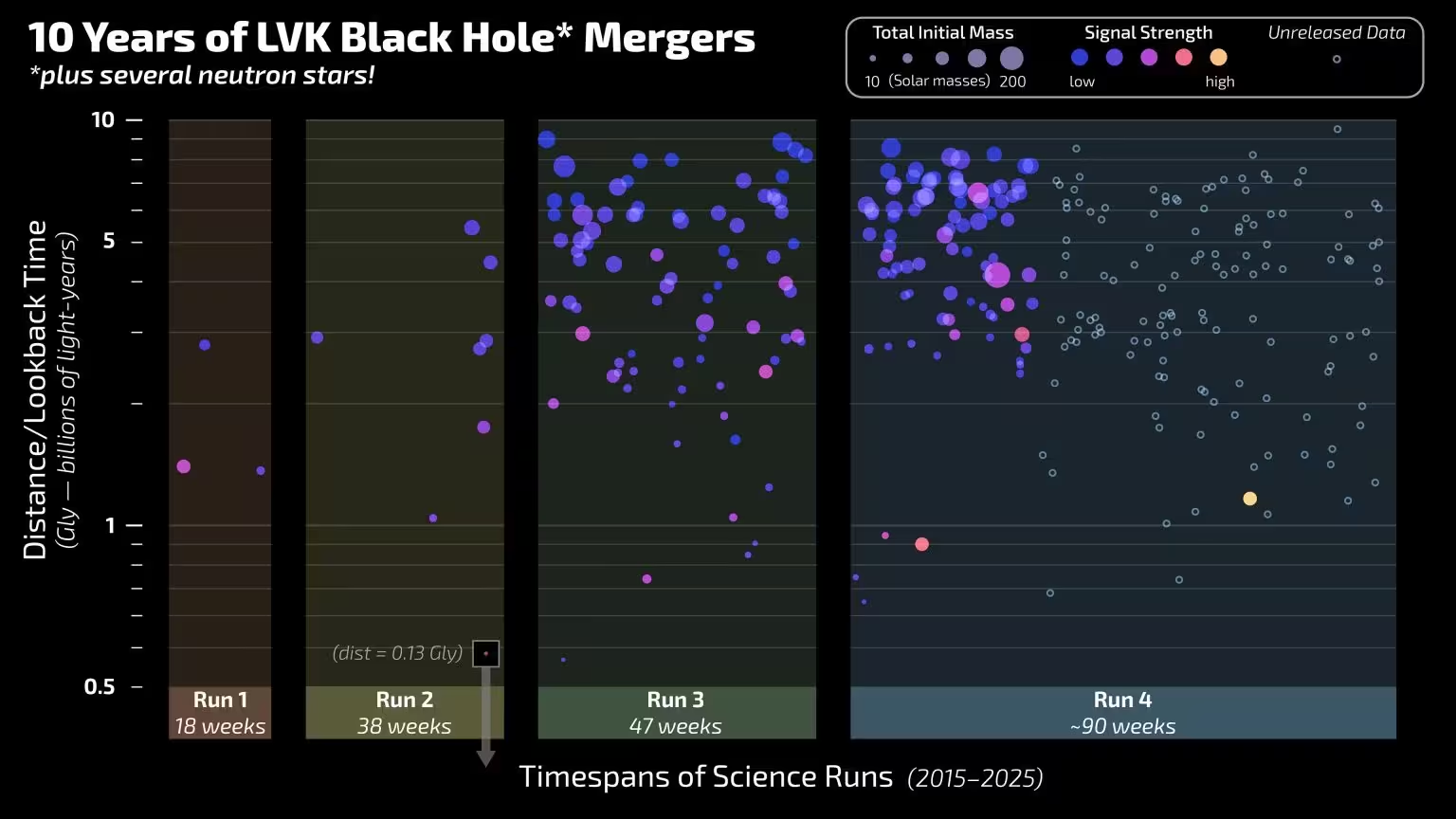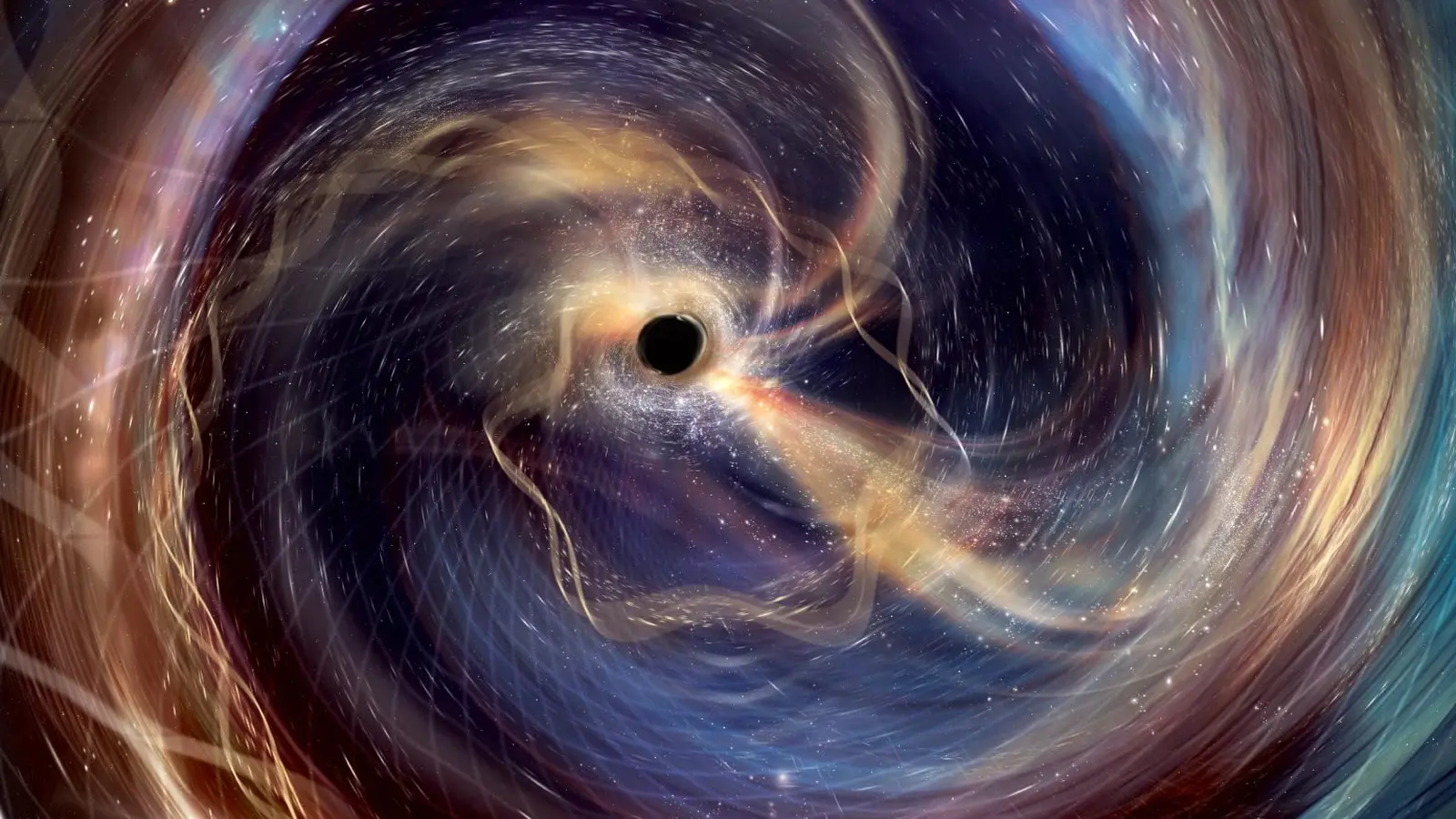15 Minutes
Ten years after gravitational waves first opened a new window on the cosmos, a remarkably clean signal from a binary black hole merger has given scientists their strongest observational test yet of Stephen Hawking's black hole area theorem. The detection, labeled GW250114, arrived thanks to upgrades in the global network of gravitational-wave observatories and allowed researchers to actually 'hear' the final black hole ring like a struck bell.
From Einstein's ripples to a new kind of astronomy
In September 2015 the Laser Interferometer Gravitational-Wave Observatory, LIGO, recorded a tiny, extraordinary disturbance: two black holes merging about 1.3 billion light-years away. That first confirmed detection of gravitational waves fulfilled a prediction from Einstein's general relativity and inaugurated gravitational-wave astronomy. Since then, LIGO's twin detectors in the United States have operated alongside Europe’s Virgo and Japan’s KAGRA in a global network commonly called LVK. Together they have converted faint spacetime distortions into a steady stream of discoveries that probe the most violent events in the universe.

Clear Signal Sheds Light on Black Holes
Gravitational waves are not light; they are minuscule stretches and squeezes of spacetime itself. Detecting them requires instruments capable of measuring length changes far smaller than a proton. That extreme sensitivity, achieved through careful engineering and quantum-limited techniques, is what has moved the field from a handful of detections to hundreds of candidate events across successive observing runs.
GW250114: a clearer, louder black hole merger
On January 14, 2025 the upgraded LIGO instruments recorded GW250114, a merger of two black holes roughly 30 to 40 times the mass of the Sun and located a bit over a billion light-years away. At first glance this system looks similar to the original GW150914 detection, but the signal-to-noise ratio and the reduced background noise made all the difference. Ten years of improvements — in suspension systems, laser stability, noise control, and quantum-enhancement methods — produced data where the telltale features of the merger stood out with unprecedented clarity.

This chart plots discoveries made by the LIGO-Virgo-KAGRA (LVK) network since LIGO’s first detection, in 2015, of gravitational waves emanating from a pair of colliding black holes. The detections consist mainly of black hole mergers, but a handful involve neutron stars (either black hole-neutron star collisions or neutron star-neutron star collisions). Credit: LIGO/Caltech/MIT/R. Hurt (IPAC)
Because the detectors were quieter, analysts could extract fine details from the waveform: the inspiral, the rapid plunge and merger, and the subsequent ringdown as the newborn black hole returned to equilibrium. That ringdown portion, though brief and faint in earlier detections, carried vital information about the remnant's mass, spin, and geometry.
What the data revealed about Hawking's theorem
One of the most intriguing theoretical results in black hole physics is Stephen Hawking's area theorem, proposed in 1971. In simple terms it states that the total surface area of black hole event horizons cannot decrease in any classical process. When two holes merge, their masses combine and gravitational radiation carries away energy and angular momentum, but according to the theorem the final black hole's horizon area should be at least as large as the sum of the original areas.
Using GW250114, the LVK collaboration made the most precise observational test yet of that statement. The two progenitor black holes had a combined horizon area amounting to roughly 240,000 square kilometers — a figure comparable to the size of the United Kingdom. After the merger, careful analysis of the ringdown modes produced an estimate for the remnant's area of about 400,000 square kilometers, closer to the size of Sweden. That increase is consistent with Hawking's prediction, and the statistical confidence reached with GW250114 is extraordinarily high: the team reports a significance far exceeding prior tests.
Hearing a black hole like a bell: ringdown modes and their importance
When a black hole forms from a violent event such as a merger, it briefly oscillates. Those oscillations, called quasi-normal modes, are analogous to the normal modes of a struck bell — each mode has a characteristic frequency and damping time. Extracting multiple ringdown modes from noisy data has been a long-standing goal because they encode the remnant's mass and spin independently from the inspiral phase.
In the GW250114 data analysts were able to confidently identify two distinct ringdown modes. The two tones have similar frequencies but decay at different rates, and isolating them required both exceptional detector sensitivity and advanced signal-processing methods. With both modes identified, the researchers could cross-check mass and spin estimates derived from earlier parts of the signal. The agreement among these independent measurements is a powerful test of general relativity in the strong-field, dynamical regime.
Listen for the low ‘whoosh’ rising out of the background static—that’s the sound of space-time itself rippling. Notice how much quieter the background noise is behind GW250114 compared to GW150914, an indication of how dramatically LIGO’s sensitivity has improved over the past decade. Credit: LIGO/Derek Davis (URI)
Why multiple modes matter for fundamental physics
Detecting multiple ringdown modes opens pathways to tests of black hole uniqueness theorems and possible extensions of general relativity. If ringdown frequencies or damping rates had diverged from theoretical predictions, it could indicate new physics — for example, alternative gravity theories or exotic compact objects that mimic black holes. So far GW250114's ringdown behaves as expected, reinforcing Einstein's predictions to new precision. Another LVK analysis also searched for an additional higher-frequency tone and set stringent bounds on its amplitude, further constraining departures from the standard picture.
How the LVK network and detector upgrades made this possible
The leap from the first detections to the clarity of GW250114 is the product of continuous upgrades and a growing, collaborative observing network. LIGO's hardware improvements included better seismic isolation, higher-power and more stable lasers, improved mirror coatings, and quantum noise reduction strategies such as squeezed light. Virgo and KAGRA also contributed with their own hardware and analysis improvements, and together the LVK collaboration refines pipelines for low-latency alerts and high-fidelity parameter estimation.
Beyond hardware, improvements in computing and waveform modeling have been crucial. Numerical relativity simulations use supercomputers to predict waveforms from mergers across a broad range of masses and spins. These templates are matched to the detector strain data to extract physical parameters. For GW250114, simulations run on systems such as the NSF's Frontera supercomputer enabled precise comparisons between theory and observation.
Simulating the merger and interpreting the waveform
A numerical relativity simulation of the recently observed GW250114 event, a binary black hole merger detected by LIGO on January 14, 2025. The blue and white surface shows a two- dimensional slice of the gravitational waves spiraling outward as the black holes orbit one another. Throughout this inspiral, the gravitational waves grow in magnitude, peaking as the black holes merge, and then decreasing rapidly as the newly formed remnant black hole settles. The observed gravitational-wave signal from GW250114 is shown below in white. In comparison, the gray line shows much noisier data from LIGO’s first gravitational-wave observation, GW150914. While the amplitudes of these signals are comparable, significant improvements in detector sensitivity over the past decade have vastly reduced the amount of noise present in GW250114 relative to GW150914. Credit: Deborah Ferguson, Derek Davis, Rob Coyne (URI) / LIGO / MAYA Collaboration. Simulation performed with NSF’s TACC Frontera supercomputer.
Matching waveform models to the measured strain allows scientists to estimate masses, spins, orientations, and distances. Importantly, it also lets them partition the signal into inspiral, merger, and ringdown contributions and test whether each segment behaves as predicted by general relativity.
Beyond black holes: neutron stars and multi-messenger alerts
While black hole mergers dominate the LVK catalog, neutron star collisions remain among the most astrophysically rich signals. In 2017, the world watched as a binary neutron star merger produced both gravitational waves and a bright electromagnetic counterpart — a kilonova that launched heavy elements into space and was seen across the electromagnetic spectrum. That multi-messenger triumph proved that coordinated alerts linking gravitational-wave detectors and telescopes can reveal new physics about element formation, nuclear matter, and the dynamics of relativistic jets.
Today the LVK network issues rapid alerts for candidate neutron star events so the astronomical community can point telescopes and satellites to likely sky regions. These coordinated observations remain essential for piecing together the complete story of transient cosmic events.
Major discoveries and surprising finds so far
Over the past decade LVK has expanded our knowledge of compact objects in several ways. The collaborations reported the first detections of black hole–neutron star binaries, found mergers with unexpected mass asymmetries, and identified black holes lighter than many models predicted — challenging the notion of a clear mass gap between neutron stars and black holes. At the opposite extreme, LVK has observed a merger with a remnant mass near 225 solar masses, the largest of its kind to date, dwarfing previous records.
These discoveries have important consequences for stellar evolution, supernova models, and our understanding of how black holes grow and pair up in dense stellar environments or galactic nuclei.
Expert Insight
Dr. Ananya Rao, a fictional astrophysicist specializing in gravitational-wave data analysis, offers context: 'GW250114 is the kind of event that demonstrates how incremental improvements in instrumentation and modeling accumulate into big science. When you reduce the background noise by orders of magnitude, features that were previously speculative become measurable. Detecting multiple ringdown modes lets us interrogate strong gravity in ways that were pure theory a decade ago.'
She adds, 'Tests of the area theorem are not just a curiosity. They probe the consistency of the framework that links horizon dynamics to thermodynamic ideas like entropy. The more events we can measure this cleanly, the tighter the constraints on alternative theories that try to modify gravity at short distances.'
What this means for theoretical physics and quantum gravity
The black hole area theorem sits at the crossroads of general relativity and thermodynamics. Jacob Bekenstein and Stephen Hawking helped frame the idea that a black hole's horizon area is proportional to its entropy, leading to deep questions about information, unitarity, and quantum gravity. Observational confirmations of classical theorems, such as the area increase in mergers, place boundary conditions on proposed quantum corrections and on models that attempt to reconcile gravity with quantum mechanics.
In short, precise gravitational-wave measurements pin down the classical baseline that any quantum theory must reproduce in the appropriate limit. Each high-fidelity detection like GW250114 narrows the room for exotic alternatives and helps guide theorists toward viable paths for unifying the laws of physics.
International collaboration and the road ahead
The LVK network is an international effort. LIGO's two detectors in the United States work with Virgo in Italy and KAGRA in Japan to triangulate sky locations, improve parameter estimation, and provide redundancy. More detectors mean better localization of transient sources and richer waveform information. The team estimates the network currently sees approximately one black hole merger every three days, with hundreds of events cataloged and many more candidates still under review.
'Analyzing strain data from the detectors to detect transient astrophysical signals, send out alerts to trigger follow-up observations from telescopes or publish physics results gathering information from up to hundreds of events is quite a long journey,' says Nicolas Arnaud, CNRS researcher in France and Virgo coordinator of the fourth science run. 'Out of the many skilled steps that such a complex framework requires, I see the humans behind all these data, in particular those who are on duty at any time, watching over our instruments. There are LVK scientists in all regions, pursuing a common goal: literally, the Sun never goes down above our collaborations!'
Plans for next-generation observatories
Scientists are already designing the instruments that will expand the gravitational-wave horizon by orders of magnitude. In Europe the Einstein Telescope envisions one or more underground interferometers with arms longer than 10 kilometers, optimized for low-frequency sensitivity. In the United States, the Cosmic Explorer concept proposes LIGO-like interferometers with 40-kilometer arms, which would probe much earlier cosmic epochs and detect mergers across most of cosmic history.
Beyond terrestrial detectors, the LISA space mission will open low-frequency gravitational-wave astronomy from orbit, sensitive to supermassive black hole mergers and compact binaries inaccessible to ground-based instruments. Together, these facilities could allow us to listen to the universe in multiple frequency bands, much like radio, optical, and X-ray astronomy do today.
Why larger detectors matter
Bigger detectors improve strain sensitivity and expand the frequency range. This yields three major benefits: first, fainter and more distant events become detectable; second, waveforms are captured with higher fidelity, making it easier to separate modes and measure parameters; and third, low-frequency sensitivity helps catch slow, massive mergers whose inspiral can last months or years. That long lead time is especially useful for planning coordinated electromagnetic observations for multi-messenger science.
Technology challenges and opportunities
Building the next generation of detectors involves several technical challenges: achieving extreme thermal and seismic isolation, producing massive mirrors with ultra-low mechanical loss coatings, and scaling up high-power lasers while controlling quantum noise. Advances in materials science, cryogenics, quantum optics, and control systems will all play a role. At the same time, computational advances in waveform modeling and machine learning will help analyze the deluge of signals expected from more sensitive observatories.
Broader scientific and cultural impact
Gravitational-wave discoveries have rapidly become centerpiece topics in public science discourse. They reshuffle how we think about stellar death, black hole formation, and the synthesis of heavy elements. The field also exemplifies global scientific cooperation, with researchers across continents sharing hardware, software, data, and credit. Educationally, the excitement of 'hearing' black holes energizes interest in physics, engineering, and computational science among students and the public alike.
As instrumentation continues to improve, gravitational-wave astronomy will increasingly intersect with other observatories, particle detectors, and theoretical work, creating a richer, more interconnected picture of the dynamic universe.
For now, GW250114 stands as a milestone: a remarkably clear cosmic chord that both confirms a classic theoretical prediction and demonstrates how progress in measurement technologies can turn theory into tested science. As more loud, clear events are caught, we should expect not only tighter tests of general relativity but also opportunities for unexpected discoveries that challenge our current models.
The global LVK network is essential to gravitational-wave astronomy. With three or more detectors operating in unison, we can pinpoint cosmic events with greater accuracy, extract richer astrophysical information, and enable rapid alerts for multi-messenger follow-up. Virgo is proud to contribute to this worldwide scientific endeavor.
In the coming years, the detectors will be further refined, and new observatories will extend our reach deeper into space and back toward the universe's earliest epochs. Each upgrade and additional observatory increases the chance of capturing even rarer or subtler signals — possibly including signatures that point beyond classical general relativity.
Source: scitechdaily
Comments
Tomas
Is this even conclusive tho? stats sound solid but what about systematic errors, detector calibration issues, or unknown noise sources… if that’s real then wow
mechbyte
Makes sense tbh. tech upgrades + better sims = clearer data, finally real ringdown modes visible. neat.
astroset
wow, that ringdown imagery gave me chills. hearing a black hole like a bell… unreal. still wrapping my head around the area bit, but lovely


Leave a Comment